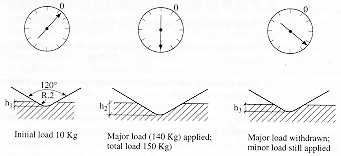 |
 |
 |
 |
 |
 |
 |
 |
 |
|
|
|
|
|
|
|
|
|
|
|
|
|
|
|
|
|
|
|
|
|
|
|
|
|
|
|
|
|
|
|
|
|
|
|
|
|
|
|
|
|
|
|
The
hardness of a material is a measure of its ability to resist plastic deformation.
Hardness testing devices push an indenter into the sample under a known
load and measure the penetration depth. This penetration is then used to
provide an arbitrary hardness scale that is both load and indenter dependent.
The diagram shows the loading sequence for a Rockwell C-scale hardness
test made using a diamond indenter with an included angle of 1200.
Initial contact is made with the clean sample surface and the indenter
is preloaded to 10 kg, after which the penetration scale is set to zero. |
|
|
|
|
|
|
|
|
|
 |
|
|
|
|
|
|
|
|
|
|
|
From:
Wakil, "Materials Science and Engineering, Laboratory Manual," PWS (1993) |
|
|
|
|
|
|
|
|
|
|
|
|
|
|
|
|
|
|
|
|
|
The
load is then increased to 150 kg and the system is allowed to flow (plastically
deform) under the indenter until the pointer comes to rest. The major load
is then removed and the indenter returned to the 10 kg load, the pointer
moving 'backwards' as elastic deformation is recovered. The total plastic
flow due to the major load is then measured from the final pointer position.
The reading must be made on a sample that is clean, well supported, and
thick enough, and the measurement must be made at least 10 indentation
diameters from the edge of the sample if it is to be representative and
reproducible. |
